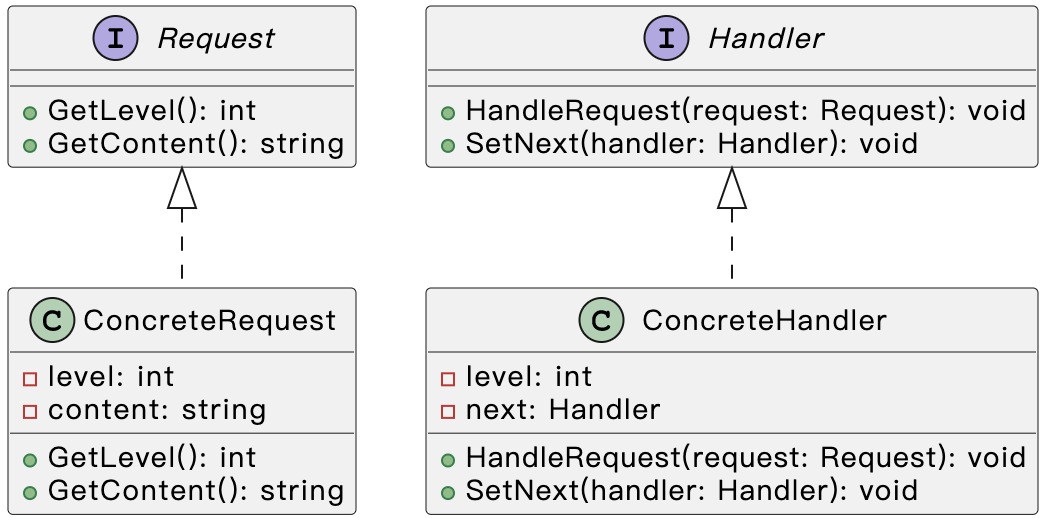责任链模式是一种行为设计模式, 允许你将请求沿着处理者链进行发送。 收到请求后, 每个处理者均可对请求进行处理, 或将其传递给链上的下个处理者
逻辑结构

代码实现
代码路径:https://github.com/XBoom/DesignPatterns/tree/main/17_Chain
-
首先,定义一个请求接口
1
2
3
4
5// Request 请求接口
type Request interface {
GetLevel() int
GetContent() string
} -
定义一个处理者接口
Handler,该接口定义了处理请求的方法1
2
3
4
5// Handler 处理者接口
type Handler interface {
HandleRequest(request Request)
SetNext(handler Handler)
} -
具体处理类
1
2
3
4
5
6
7
8
9
10
11
12
13
14
15
16
17
18
19
20
21
22
23
24
25// ConcreteHandler 具体处理者类
type ConcreteHandler struct {
level int
next Handler
}
func NewConcreteHandler(level int) *ConcreteHandler {
return &ConcreteHandler{
level: level,
}
}
func (h *ConcreteHandler) HandleRequest(request Request) {
if request.GetLevel() == h.level {
fmt.Printf("Handler%d 处理请求:%s\n", h.level, request.GetContent())
} else if h.next != nil {
h.next.HandleRequest(request)
} else {
fmt.Println("没有合适的处理者处理该请求")
}
}
func (h *ConcreteHandler) SetNext(handler Handler) {
h.next = handler
} -
最后,定义具体的处理者结构体,实现
Handler接口1
2
3
4
5
6
7
8
9
10
11
12
13
14
15
16
17
18
19
20// ConcreteRequest 具体请求类
type ConcreteRequest struct {
level int
content string
}
func NewConcreteRequest(level int, content string) *ConcreteRequest {
return &ConcreteRequest{
level: level,
content: content,
}
}
func (r *ConcreteRequest) GetLevel() int {
return r.level
}
func (r *ConcreteRequest) GetContent() string {
return r.content
}
运行
1 | handler1 := NewConcreteHandler(1) |
结果
1 | Handler2 处理请求:请求 1 |
错误处理
错误处理也是一种类似职责链的逻辑
1 | type check struct { |
Functiton Option
Function Option 也算是一种职责链模式
1 | type Person struct { |
函数选项模式可以实现一些类似职责链的行为,但它并不是职责链模式的直接实现。职责链模式更加注重请求的传递和处理过程,通常涉及多个处理者的协作,而函数选项模式主要用于对象构造和定制
总结
- 可以控制请求处理的顺序,
- 单一职责原则。 可对发起操作和执行操作的类进行解耦
- 开闭原则。 可以在不更改现有代码的情况下在程序中新增处理者
- 当职责链过长,可能需要遍历整个链才能被处理
- 适用于异常处理链、权限验证等